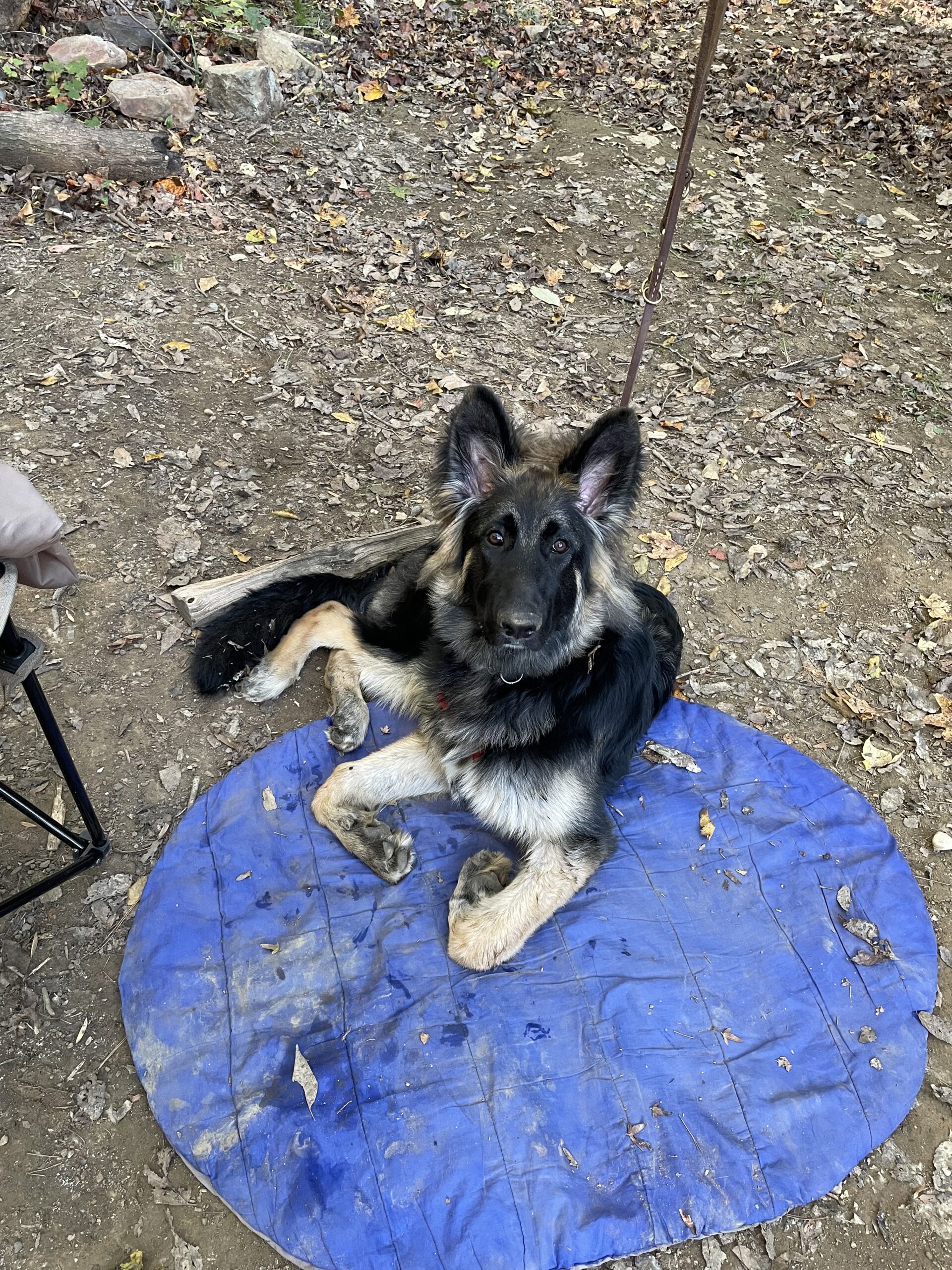Station training – or place training – is a foundational tool that we can use to help dogs in a wide variety of ways! At it’s core, station training helps us teach our dogs to settle, take in the world around them, and regulate their excitement levels in a variety of situations.
Your dog knows how to play the place game when you sit down next to their spot and they immediately go to their spot, lay there calmly, and are able to wait one minute between treats.
How to Play
You’ll need your dog, a bed*, a leash, a place to sit, and 15-20 treats. Teach your dog to play this game first in a quiet area without distractions.
*Choose a bed that is big enough for your dog’s entire body to fit on it, comfortable, and fairly easy to move as needed. If you’re taking your training on the road, choose a portable bed such as a yoga mat or camping dog bed.
Getting On The Station
- Put your bed next to your chair.
- Use a treat to lure your dog onto their spot. When they have all four feet on the bed, say “Yes!” and deliver their treat onto the middle of the end of their bed.
- Some dogs may need some extra encouragement! If your dog seems to have trouble getting all four feet on, don’t be afraid to say “Yes!” for one or two feet on the bed at first and work your way up to all four.
- Place a treat on their spot between their paws every 2-3 seconds for 10 seconds. (If they leave their spot, just lure them back on!)
- After 5-10 treats, say “Free!”, then toss a treat off their bed, so that when they return to you for more they automatically step back onto their bed.
- After they eat their reset cookie, say “Go to your spot!” and lure them back on. Repeat 2-3 times, for 10 seconds each time.
- After a few reps, start luring your dog into a down when they get on the bed. Place the treat between their paws to help them stay in position.
Adding Duration
When your place behavior is solid and your dog reliably heads to their place on cue and lays down for 10 seconds, you can focus on adding more duration.
- Start sitting next to your dog while you train. Don’t stare straight at them – keep it casual and relaxed.
- Slowly add more time between treats. Once they find it super easy to lay down for a treat every 3 seconds, increase to every 5 seconds, then 10 seconds. Mix it up a bit – sometimes wait 3 seconds, then 8, then 2, then 10, and so on.
- Use your dog’s body language as your gauge. If they start to wiggle and shift or look like they might get up, you may have gone a little bit too long too soon! Try shortening your time.
- If your dog gets up, don’t fret! Just ask them to get back on their bed and praise them when they do – but don’t give them a treat right away! Wait a few seconds after they lay down before delivering a treat.
Don’t Forget The Leash!
Most dogs will need to be able to station both on-leash and off-leash. If you are going to be using their spot in any situation where your dog would be leashed, make sure to practice with the leash early on!
If you’re practicing inside, make sure you use a house leash – context is key. A house leash is a leash that is only used for training inside the house. This helps prevent our dogs from getting overexcited by the prospect of going on a walk when in reality we are training in the house.
- Practice a few reps of place without the leash, then leash up your dog before asking them to return to their bed.
- Train like normal, but make things easier to help your dog stay successful with the distraction of the leash.
- You can lure your dog onto their spot if they seem to have forgotten how.
- At first, reward more frequently than before.
- Work your way back up to the duration you had without the leash.
Station Training for Behavior Modification
Stations are a powerful tool for helping our dogs change their feelings about things. When using stations as part of a behavior modification program, follow the advice and instructions given by your trainer as part of your specific program. Here are some general guidelines to keep in mind:
- Your dog’s spot is their safe space. Do not allow anyone to interact with them when they are on their spot – this means no talking directly to them, no approaching them, and certainly no petting them. This goes for other dogs, too!
- One dog per spot, no swapping or sharing. In multi-dog households, it is very easy for feelings to be hurt with place-sharing. Unless otherwise directed by your trainer, do not encourage dogs to swap places willy-nilly and don’t reward multiple dogs on the same spot.
- Don’t pressure your dog to lay down on their spot. If your dog normally lays down immediately upon getting to their bed and they suddenly seem like they don’t want to – listen up! They’re probably not comfortable with the situation. Give them time to decompress and make the choice to lay down on their own.



